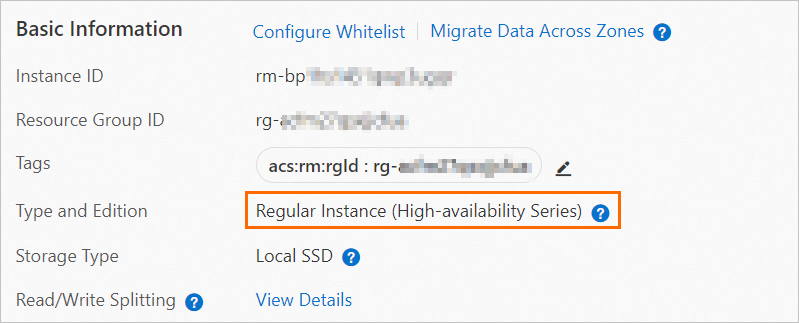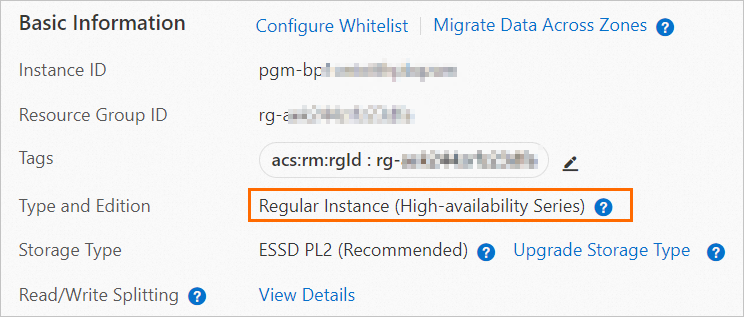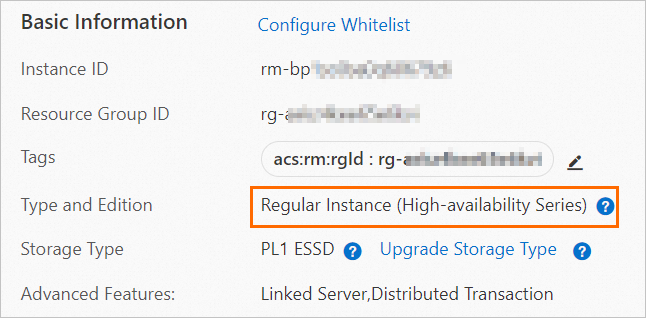This topic describes the RDS editions and the scenarios of each RDS edition. This topic also describes how to view and change the RDS edition of an RDS instance.
RDS editions of ApsaraDB RDS for MySQL
RDS editions of ApsaraDB RDS for PostgreSQL
Description of RDS editions of ApsaraDB RDS for SQL Server
RDS editions of ApsaraDB RDS for MariaDB
RDS edition | Description | Scenario |
RDS Basic Edition | | |
RDS High-availability Edition | The database system consists of a primary RDS instance and a secondary RDS instance. These instances work in HA mode and support automatic failover. The secondary RDS instance cannot be accessed. You can create read-only RDS instances to increase the read capability of your database system. For more information, see Create a read-only ApsaraDB RDS for MySQL instance.
| Production databases for large and medium-sized enterprises Databases that are used in industries such as the Internet, IoT, e-commerce, logistics, and gaming
|
RDS Cluster Edition | The database system consists of a primary RDS instance and multiple secondary RDS instances. These instances work in HA mode and support automatic failover. The secondary RDS instances can be accessed. This increases the read capability of your database system. You can create multiple secondary RDS instances to increase the read capability of your database system.
| Production databases for large and medium-sized enterprises Databases that are used in industries such as Internet-based new retail and automobile manufacturing, and databases that are used for Enterprise Resource Planning (ERP) systems
|
Change of the RDS edition
Check on the RDS edition
You can log on to the ApsaraDB RDS console, find the RDS instance, and then go to the page to view the RDS edition of the RDS instance.

Supported instance types
Supported features
For more information, see Features.
Create an RDS instance
For more information, see Create an ApsaraDB RDS for MySQL instance.
RDS edition | Description | Scenario |
RDS Basic Edition | | |
RDS High-availability Edition | The database system consists of a primary RDS instance and a secondary RDS instance. These instances work in high availability (HA) mode and support automatic failover. The secondary RDS instance cannot be accessed. You can create read-only RDS instances to increase the read capability of your database system. For more information, see Create a read-only ApsaraDB RDS for PostgreSQL instance.
| Production databases for large and medium-sized enterprises Databases that are used in industries such as the Internet, IoT, e-commerce, logistics, and gaming
|
Change of the RDS edition
You can upgrade an RDS instance that runs PostgreSQL 10 or later from RDS Basic Edition to RDS High-availability Edition. For more information, see Upgrade an ApsaraDB RDS for PostgreSQL instance from RDS Basic Edition to RDS High-availability Edition.
Check on the RDS edition
You can log on to the ApsaraDB RDS console, find the RDS instance, and then go to the Basic Information page to view the edition of the RDS instance.

Supported instance types
For more information, see Primary ApsaraDB RDS for PostgreSQL instance types.
Supported features
For more information, see Features.
Create an RDS instance
For more information, see Create an ApsaraDB RDS for PostgreSQL instance.
RDS edition | Description | Scenario |
RDS Basic Edition | | |
RDS High-availability Edition | The database system consists of a primary RDS instance and a secondary RDS instance. These instances work in high availability (HA) mode and support automatic failover. The secondary RDS instance cannot be accessed. Read-only RDS instances are not supported.
| Production databases for large and medium-sized enterprises Databases that are used in industries such as the Internet, IoT, e-commerce, logistics, and gaming
|
RDS Cluster Edition | The database system consists of a primary RDS instance and a secondary RDS instance. These instances work in HA mode and support automatic failover. The secondary RDS instances can be accessed. This increases the read capability of your database system. You can create up to seven read-only RDS instances to improve the read capability. However, read-only RDS instances do not participate in the primary instance election or workload switchover. For more information, see Create a read-only ApsaraDB RDS for SQL Server instance.
| Production databases for large and medium-sized enterprises Databases that are used in industries such as Internet-based new retail and automobile manufacturing, and databases that are used for ERP systems
|
Change the RDS edition of an RDS instance
If your RDS instance runs one of the following database engine versions, you can upgrade the RDS instance from RDS Basic Edition to RDS High-availability Edition. For more information, see Upgrade the major engine version.
SQL Server 2022 SE, SQL Server 2019 SE, SQL Server 2017 SE, SQL Server 2016 SE, and SQL Server 2014 SE
SQL Server 2022 Web, SQL Server 2019 Web, SQL Server 2017 Web, SQL Server 2016 Web, and SQL Server 2012 Web
SQL Server 2016 EE and SQL Server 2012 EE Basic
If your RDS instance runs one of the following database engine versions, you can upgrade the RDS instance from RDS High-availability Edition to RDS Cluster Edition. For more information, see Upgrade the major engine version.
SQL Server 2022 SE, SQL Server 2019 SE, SQL Server 2017 SE, SQL Server 2016 SE, SQL Server 2014 SE, and SQL Server 2012 SE
SQL Server 2016 EE, SQL Server 2014 EE, and SQL Server 2012 EE
View the RDS edition of an RDS instance
You can log on to the ApsaraDB RDS console, find the RDS instance, and then go to the Basic Information page to view the edition of the RDS instance.

Instance types supported by various RDS editions
For more information, see Instance types for primary ApsaraDB RDS for SQL Server instances.
Features supported by various RDS editions
For more information, see Features.
Create an RDS instance
For more information, see Create an ApsaraDB RDS for SQL Server instance.
RDS edition | Description | Scenario |
RDS High-availability Edition | The database system consists of a primary RDS instance and a secondary RDS instance. These RDS instances work in high availability (HA) mode. Dual-zone disaster recovery is supported. The secondary RDS instance cannot be accessed. | Production databases for large and medium-sized enterprises Databases that are used in industries such as the Internet, IoT, e-commerce, logistics, and gaming
|
Check on the RDS edition
You can log on to the ApsaraDB RDS console, find the RDS instance, and then go to the Basic Information page to view the edition of the RDS instance.

Supported instance types
For more information, see Instance types.
Supported features
For more information, see Features.
Create an RDS instance
For more information, see Create an ApsaraDB RDS for MariaDB instance.
 Elastic Compute Service (ECS)
Elastic Compute Service (ECS)
 Container Compute Service (ACS)
Container Compute Service (ACS)






























